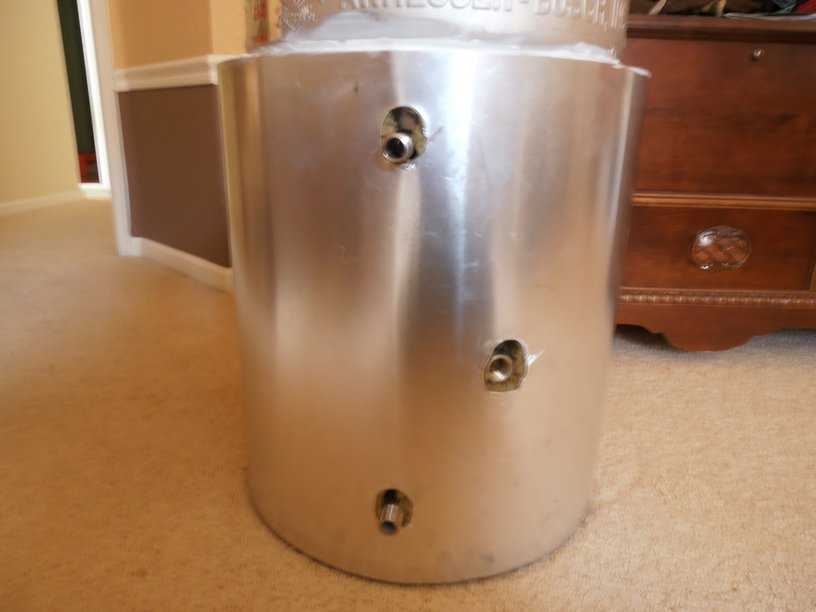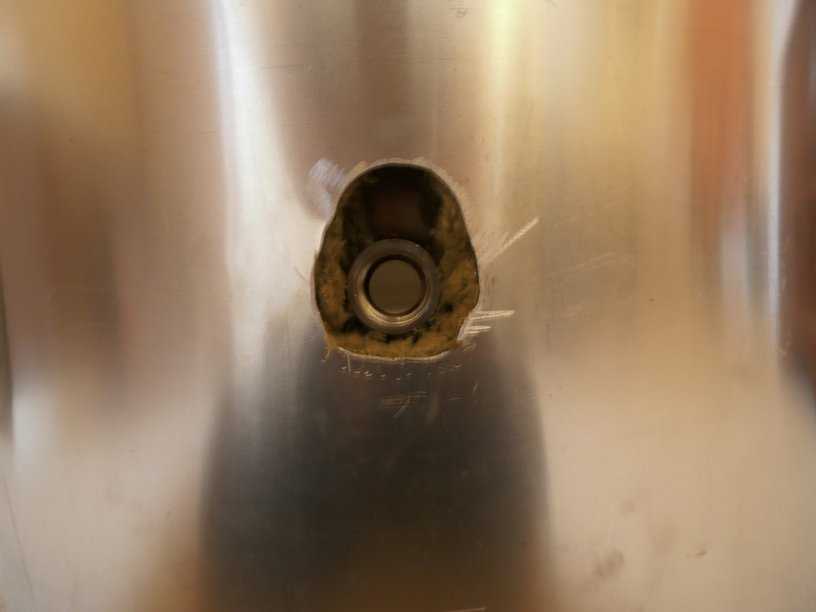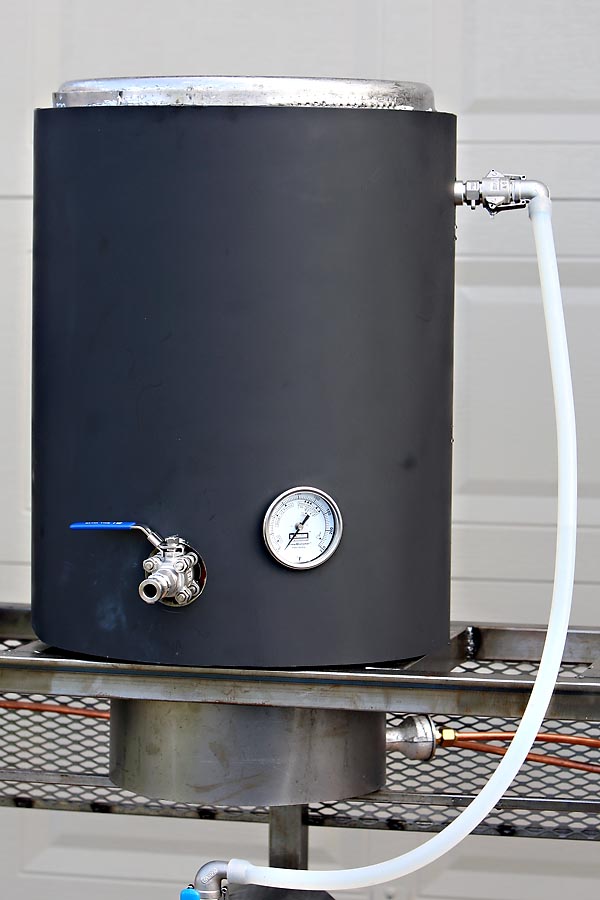You are using an out of date browser. It may not display this or other websites correctly.
You should upgrade or use an alternative browser.
You should upgrade or use an alternative browser.
Direct Fire MLT Insulation Project
- Thread starter Bobby_M
- Start date

Help Support Homebrew Talk:
This site may earn a commission from merchant affiliate
links, including eBay, Amazon, and others.
When I did mine I used sheet metal that was a bit thicker and harder to work with so it was necessary to prebend it. If I had glued the wool on first I think just the amount of metal bending i was doing would have it crumbling apart.
Bend metal, spray the heck out of it with Super 88 and then use tied downs to hold the metal in place. Drills holes and pop rivot buckles on.
I too have never removed mine from my keg.
So wait. How do you get the wool to stick to the keggle if you aren't applying adhesive to the flashing first? Also how are you strapping the flashing to the keggle and then drilling holes? Wouldn't the big bulge around the fittings cause issues?
Alright, sorry for the multiple questions. I have a piece of aluminum (22 Gauge) that's only 19" tall. I don't know why I ordered that size. So now I have about a 4" differential to the top of the keggle. With this in mind, how would you suggest I position the flashing? Leave a big gap at the top? Bottom? Or split the difference between top and bottom?
Thanks.
Thanks.
So I finally built my Bobby inspired insulated mash tun. If you see the enclosed picture I made the damn holes around my coupling too big. I had to readjust after I cut smaller ones which caused the big holes. My question is how do I cover these gaps so the wool does not get wet?
I was thinking of smaller pieces of aluminum (with the exact right size hole) that I could rivet in place. But I will still have some leakage without silicon caulking or something. My concern is that at the bottom of the kettle temps might get high enough to melt the silicon? Not sure what kind of temp range the silicon could handle or whether the bottom of the aluminum sheeting gets hot enough to even worry about it?
Would there be any other type of waterproof adhesive that can handle high temps?
Any suggestions would be greatly appreciated.



I was thinking of smaller pieces of aluminum (with the exact right size hole) that I could rivet in place. But I will still have some leakage without silicon caulking or something. My concern is that at the bottom of the kettle temps might get high enough to melt the silicon? Not sure what kind of temp range the silicon could handle or whether the bottom of the aluminum sheeting gets hot enough to even worry about it?
Would there be any other type of waterproof adhesive that can handle high temps?
Any suggestions would be greatly appreciated.




$33.99 ($17.00 / Count)
$41.99 ($21.00 / Count)
2 Pack 1 Gallon Large Fermentation Jars with 3 Airlocks and 2 SCREW Lids(100% Airtight Heavy Duty Lid w Silicone) - Wide Mouth Glass Jars w Scale Mark - Pickle Jars for Sauerkraut, Sourdough Starter
Qianfenie Direct

$479.00
$559.00
EdgeStar KC1000SS Craft Brew Kegerator for 1/6 Barrel and Cornelius Kegs
Amazon.com

$7.79 ($7.79 / Count)
Craft A Brew - LalBrew Voss™ - Kveik Ale Yeast - For Craft Lagers - Ingredients for Home Brewing - Beer Making Supplies - (1 Pack)
Craft a Brew
![Craft A Brew - Safale S-04 Dry Yeast - Fermentis - English Ale Dry Yeast - For English and American Ales and Hard Apple Ciders - Ingredients for Home Brewing - Beer Making Supplies - [1 Pack]](https://m.media-amazon.com/images/I/41fVGNh6JfL._SL500_.jpg)
$6.95 ($17.38 / Ounce)
$7.47 ($18.68 / Ounce)
Craft A Brew - Safale S-04 Dry Yeast - Fermentis - English Ale Dry Yeast - For English and American Ales and Hard Apple Ciders - Ingredients for Home Brewing - Beer Making Supplies - [1 Pack]
Hobby Homebrew

$20.94
$29.99
The Brew Your Own Big Book of Clone Recipes: Featuring 300 Homebrew Recipes from Your Favorite Breweries
Amazon.com

$53.24
1pc Hose Barb/MFL 1.5" Tri Clamp to Ball Lock Post Liquid Gas Homebrew Kegging Fermentation Parts Brewer Hardware SUS304(Liquid Hose Barb)
yunchengshiyanhuqucuichendianzishangwuyouxiangongsi

$22.00 ($623.23 / Ounce)
AMZLMPKNTW Ball Lock Sample Faucet 30cm Reinforced Silicone Hose Secondary Fermentation Homebrew Kegging joyful
无为中南商贸有限公司

$76.92 ($2,179.04 / Ounce)
Brewing accessories 1.5" Tri Clamp to Ball Lock Post Liquid Gas Homebrew Kegging Fermentation Parts Brewer Hardware SUS304 Brewing accessories(Gas Hose Barb)
chuhanhandianzishangwu

$176.97
1pc Commercial Keg Manifold 2" Tri Clamp,Ball Lock Tapping Head,Pressure Gauge/Adjustable PRV for Kegging,Fermentation Control
hanhanbaihuoxiaoshoudian

$58.16
HUIZHUGS Brewing Equipment Keg Ball Lock Faucet 30cm Reinforced Silicone Hose Secondary Fermentation Homebrew Kegging Brewing Equipment
xiangshuizhenzhanglingfengshop

$44.99
$49.95
Craft A Brew - Mead Making Kit – Reusable Make Your Own Mead Kit – Yields 1 Gallon of Mead
Craft a Brew

$719.00
$799.00
EdgeStar KC2000TWIN Full Size Dual Tap Kegerator & Draft Beer Dispenser - Black
Amazon.com

$159.50 ($26.58 / Count)
3M High Flow Series System BREW120-MS, 5616001, For Brewed Coffee and Hot Tea, Valve-in-Head Design
Amazon.com

$53.24
1pc Hose Barb/MFL 1.5" Tri Clamp to Ball Lock Post Liquid Gas Homebrew Kegging Fermentation Parts Brewer Hardware SUS304(Liquid Hose Barb)
Guangshui Weilu You Trading Co., Ltd

$10.99 ($31.16 / Ounce)
Hornindal Kveik Yeast for Homebrewing - Mead, Cider, Wine, Beer - 10g Packet - Saccharomyces Cerevisiae - Sold by Shadowhive.com
Shadowhive
Good to know about the silicon not burning. I think I will use the aluminum sheating to cover the gaps. Maybe I can get away with just using the silicon to hold the aluminum in place and not need rivets?
Huaco
Well-Known Member
My question is how do I cover these gaps so the wool does not get wet?
If you have any sheet metal left, you could cut large donuts with the outside diameter (OD) being big enough to cover the largest of the holes. Cut the inside diameter (ID) to a nice tight fit over your pipe nipples. Drill some holes in the donuts and the sheet metal and rivet those on with some blind rivets. If you are concerned about water infiltration, you could run a bead of silicon around the inside face of the donuts prior to riveting them.
I agree that cutting some "donut" trim pieces would hide those holes just fine. You could rivet them on or just use a smear of silicone.
The term "blind rivet" is synonymous to pop rivets or what everyone pretty much understands as a rivet. There are other types that have to be cinched together with pressure from both sides. A pop rivet can be installed when one side is inaccessible or "blind".
The term "blind rivet" is synonymous to pop rivets or what everyone pretty much understands as a rivet. There are other types that have to be cinched together with pressure from both sides. A pop rivet can be installed when one side is inaccessible or "blind".
BrewHogDeluxe
Well-Known Member
Even though I am not direct firing my RIMS, I am watching for ideas on insulating my RIMS controlled MLT.
Have you seen the Keg Kozy? I saw it on here the other day, checked it out $39.95. Neoprene 7mm, keeps a keg cold for 6 hours and there are some homebrewer reviews on their website about using it on your MLT.
Getting ready to build my AG setup and I think I will try this on my MLT for temp stability.
You just can't direct fire on a keg kozy so it's not necessarily relevant to this thread (not that it doesn't have merit in its own right).
BrewHogDeluxe
Well-Known Member
You just can't direct fire on a keg kozy so it's not necessarily relevant to this thread (not that it doesn't have merit in its own right).
Oops somehow missed the direct fired part.


This still holding up, Bobby?
Wonder how it would work out if I wrapped a keg with no holes, and then drilled them. Probably just have to open up the holes in the flashing to accommodate the fittings.
It looks brand new still.
PistolsAtDawn
Well-Known Member
Bobby, that looks great! I may try to do something like this eventually, but for now I need a cheaper and easier solution for insulation.
I wasn't keen on using the reflectix either, and I saw in another thread that you had recommended using a welding blanket for insulation. I just bought this one: http://www.amazon.com/gp/product/B0057RJD0E
Do you think that will help at all? I figure I can wrap it around the MLT just to see if it makes any difference.
I wasn't keen on using the reflectix either, and I saw in another thread that you had recommended using a welding blanket for insulation. I just bought this one: http://www.amazon.com/gp/product/B0057RJD0E
Do you think that will help at all? I figure I can wrap it around the MLT just to see if it makes any difference.
Last edited by a moderator:
That stuff is a bit more of a spark shield as it's very thin 1/32". It will help a little bit by trapping a layer of air, but it's a large enough piece of material that you can use it to make an encapsulated fiberglass blanket. Get some 1 or 2" thick fiberglass insulation (unfaced, no paper or foil) and lay it down the center of that welding blanket. Then fold the blanket over the fiberglass overlapping. Use some safety pins or binder clips to hold the flaps together. That side can now face towards the MLT and it will look pretty neat and work 100x better than just the thin welding blanket.
PistolsAtDawn
Well-Known Member
Thanks, Bobby! That sounds like it would work with my direct-fired keggle and my mash tun. I'll give that a shot.
Black Island Brewer
An Ode to Beer
That stuff is a bit more of a spark shield as it's very thin 1/32". It will help a little bit by trapping a layer of air, but it's a large enough piece of material that you can use it to make an encapsulated fiberglass blanket. Get some 1 or 2" thick fiberglass insulation (unfaced, no paper or foil) and lay it down the center of that welding blanket. Then fold the blanket over the fiberglass overlapping. Use some safety pins or binder clips to hold the flaps together. That side can now face towards the MLT and it will look pretty neat and work 100x better than just the thin welding blanket.
Hey Bobby, this thread has been a great help, thanks for sticking with it. When you suggest the welding blanket wrapped around the unfaced insulation, are you suggesting that in place of the mineral wool, or on place of the whole wool/sheet metal arrangement? I'm just getting ready to insulate my direct fire MLT and figure there's no use reinventing the wheel!
Life is Good!
David
I was suggesting the thin welding blanket would make a good fiber encapsulation method for easy to find fiberglass batting. I don't think I'd use mineral wool for a soft wrap type insulation because it really does need a stiffer shell to make it nice and round. So, mineral wool + metal shell or fiberglass batting wrapped in thin welding blanket.
back from the dead LOL!!
I was reading through this thread and Bobby M referenced this "3M Super 88 spray adhesive" but i cannot find this product anywhere when i search online. What can i use in its place? I was reading and a post above stated they had a burning smell etc which could have been the adhesive they used.
What should i use?
I was reading through this thread and Bobby M referenced this "3M Super 88 spray adhesive" but i cannot find this product anywhere when i search online. What can i use in its place? I was reading and a post above stated they had a burning smell etc which could have been the adhesive they used.
What should i use?
I used the 3M adhesive spray that was mentioned in Bobby's thread and I do pick up a nasty odor each time I heat the mash tun. Over time (several years now) it has deminished substantially. However, if I were to do it again I would try omitting the spray adhesive all together but still use the silicone sealant on top to keep water out. You could always go back in and add an adhesive if you were unhappy with the results.
back from the dead LOL!!
I was reading through this thread and Bobby M referenced this "3M Super 88 spray adhesive" but i cannot find this product anywhere when i search online. What can i use in its place? I was reading and a post above stated they had a burning smell etc which could have been the adhesive they used.
What should i use?
I used the 3M adhesive spray that was mentioned in Bobby's thread and I do pick up a nasty odor each time I heat the mash tun. Over time (several years now) it has deminished substantially. However, if I were to do it again I would try omitting the spray adhesive all together but still use the silicone sealant on top to keep water out. You could always go back in and add an adhesive if you were unhappy with the results.
Agreed. I've taken mine off my keggle only once since I built it. If you can just get it on for the first time you wouldn't need any glue. That said if you google 3m Super 77 you'll find a bunch of results. That's what I used. No odor that I notice.
Agreed. I've taken mine off my keggle only once since I built it. If you can just get it on for the first time you wouldn't need any glue. That said if you google 3m Super 77 you'll find a bunch of results. That's what I used. No odor that I notice.
I was looking at that one but it is only heat resistant to 150 and is flammable. Thinking maybe step up to the one that is resistant to 230.
How about this one: http://solutions.3m.com/wps/portal/...w-VOC-25-?N=8457824+5582876+3294387807&rt=rud
Maybe i will just use your advise and skip the adhesive.
By the way, for the record, i ordered that mineral wool from McMaster Carr without a clue they were in south atlanta (im in the north metro area). The lady on the phone says, you will likely get this today. I was like yeah, okay.. sure but did not say anything. Got home today. it was on my porch.. SAME DAY delivery was just 10 bucks. Insane!
By the way, for the record, i ordered that mineral wool from McMaster Carr without a clue they were in south atlanta (im in the north metro area). The lady on the phone says, you will likely get this today. I was like yeah, okay.. sure but did not say anything. Got home today. it was on my porch.. SAME DAY delivery was just 10 bucks. Insane!
Similar threads
- Replies
- 45
- Views
- 4K
- Replies
- 13
- Views
- 4K











































